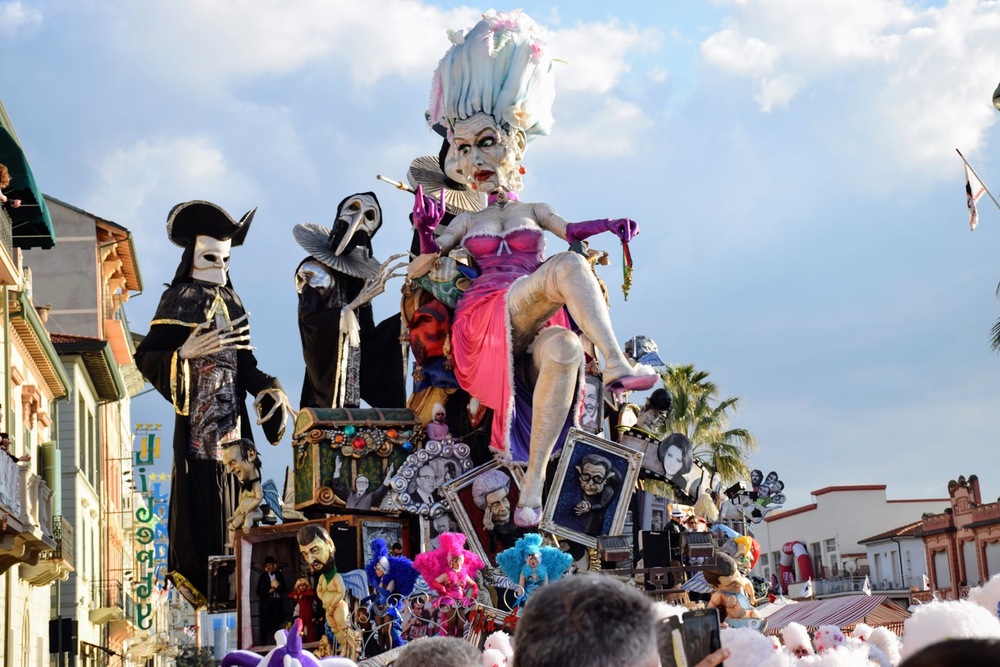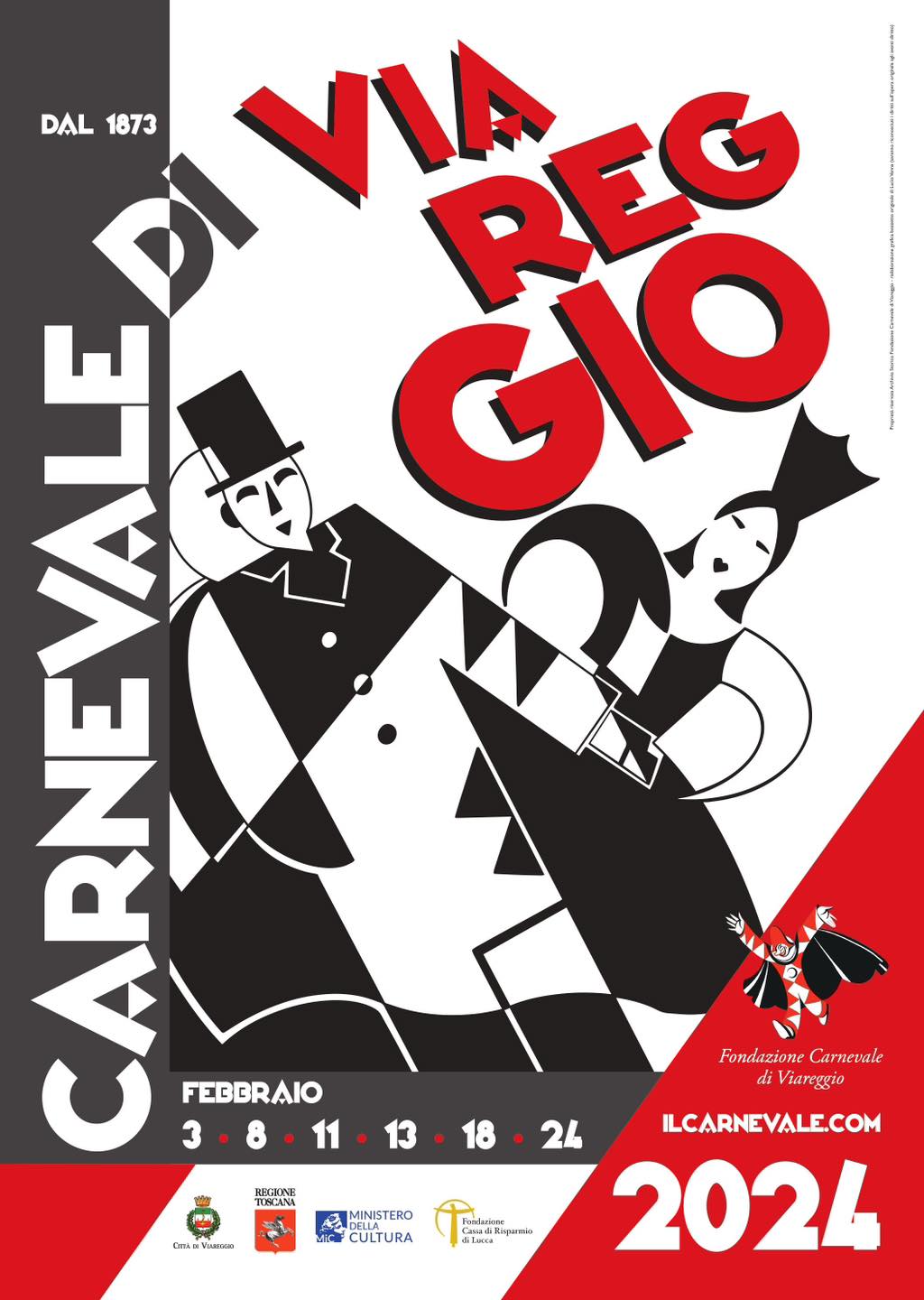Carnival of Viareggio: Carnival of Italy and Europe | History of Carnival
Discover the history of the Viareggio Carnival
The Viareggio Carnival has been considered the most important carnival in Italy and Europe for more than 150 years.
A spectacular event, gigantic allegorical floats created by poets of entertainment parade along the seafront, in a whirlwind of colours, music, confetti and streamers, pure fun and joy, which will make children, teenagers, parents and grandparents happy.
A month of local festivals, theater reviews, gastronomic events, masked parties and sporting events. Every Sunday the triple cannon shot will mark the start of the Carnival and thousands of masked people will flock to the seaside avenues to rejoice and have fun and it will invite you to do it with them.

The triple cannon shot is the unmistakable signal that the party begins in Viareggio.
Shooted from the sea, it always starts the parade of floats. As if by magic, the gigantic masks come to life with movements, music and dances. An ever new, exciting and fascinating show. Five Great Masked Courses, concentrated in a single month of great celebrations.
The history of the Viareggio carnival
The Viareggio Carnival as it is known today was born 1873: a spectacular event among the most beautiful and the greatest in the world.
Around the tables of the "caffè del Casino" the idea was born among some young people from Viareggio who, tired of the monotony of a Carnival without events, went out onto the Via Regia with about twenty decorated floats, throwing confetti and sweets left and right, tipsy with a few glasses of wine in their bodies, singing and dancing with that irreverent spirit typical of the " Tuscanaccio " which gave life to a lively and cheerful celebration born from the people, in a city born to show itself, to cheer up the eyes and the spirit in a natural theater between the sea and the mountains.
At the end of the century
The first wagons began to appear alongside the carriages, "i Quattro Mori " was the first ever. Legend has it that when bold young dancers who animated the party passed in front of the Hotel Viareggio, many good-looking ladies threw confetti and beans at the carriages full of masks, who, passing back, took revenge by throwing the confetti back in turn at all the windows. and terraces of inns where quite a few ladies and damsels were out enjoying the show, creating that irreverent and transgressive atmosphere that is experienced at the carnival today. Throwing sweets from floats is one of the carnival traditions still practiced today.
Until 1920 the "wagons" were nothing more than the carts of the Pietrasanta quarrymen.
decorated and embellished with reeds, jute wire and clay, to create the human figures and masks came artisans from Pietrasanta and for the real colors painters, but also artists such as Lorenzo Viani who collaborated as a sculptor with the chariot "the triumph of life ”.
Year after year the buildings were increasingly larger and more refined, and the carnival ceased to be just a popular festival to transform into a heartfelt event capable of attracting tourism to the city eager for joy and fun, masked balls and night parties. .
1921 was a turning point.
the event grew more and more and began to be promoted with a magazine, "Viareggio in mask" and the musical bands began to find a place on board the float entitled "Tonin di Burio", which represented the wedding party in the farmyard of a farmhouse . Music took on a fundamental role and the first official song of the Carnival was composed, “Sulla Coppa di Champagne”. It is said that the people of Viareggio asked for help from the great maestro Giacomo Puccini who was a regular visitor to the clubs of Viareggio who politely refused but suggested to ask for help from an established composer named Icilio Sadun who willingly agreed to set to music the words of the group of "carnivalari" led by Lelio Maffei.
In 1923 the first movements on the wagons began to be glimpsed. The famous "Pierrot" by Giampieri and Baroni, rolled his eyes and moved his head from right to left up and down, jets of perfume came out of his mouth which a man inside the mask built in empty plaster, in precarious balance on wooden planks, he sprayed with a pump.
You can imagine the amazement of the crowd and the roar of applause as this innovative construction passed by, which entered the annals of the Carnival and laid the foundations of one of the main characteristics of the Viareggio Carnival: all the movements are made by men and not by machines. Only in this way is it possible to obtain spectacular effects, on today's floats dozens of animators contribute to the animation of the float.
In those years an idea caused a stir:
The Night Ball, one Sunday evening, Viareggio experienced a unique show in its life as a seaside resort, a crowd of people celebrated and danced until late at night. It was the inspiration for what are today the districts that take place in the various neighborhoods of Viareggio during the carnival evenings.
1925 was a revolutionary year.
Antonio D'Arliano together with the tank drivers Pardini brothers had the brilliant idea, the plaster constructions were too heavy, the paper applied directly to the clay when it was removed deflated and lost its shape, so they experimented with something new.
They modeled a knight's head with clay, and on it they applied plaster reinforced with pieces of bale. Once dry, the plaster easily detached from the clay, creating a negative cast, which was immediately tried to be filled with paper. layered newspaper and simple glue made up of water and flour, after allowing it to dry, they discovered that the paper detached perfectly from the plaster and maintained its shape.
An enormous papier-mâché knight's head was looking at its creators, perfectly identical to how it had been modeled in clay. From then on, tank builders began to make enormous constructions that still defy the laws of physics today.
1931 was born from the mind of a young artist, Umberto Bonetti, the smiling and sly face of Burlamacco.
Viareggina mask par excellence, which, in the 1931 poster, against the background of the piers overlooking the sea, appeared in the company of Ondina, the bather symbol of the summer season. Taking inspiration from the masks of the Commedia dell'Arte and designing it in a futurist key, Bonetti wanted to summarize in the mask the two key moments of the life of the city of Viareggio: summer (with the white and red colors typical of the umbrellas on the beaches in the 1930s) and Carnival. Today Burlamacco finds a place among the Italian masks in Rome at the Museum of Folklore and Tradition and is exhibited in Paris at the Musée de l'Homme.
1946, after the twenty years of fascism, was the year of the rebirth of Carnival.
The irrepressible desire for redemption of the entire city also shines through in the incipit of the official song: "Rise again even more beautiful Viareggio, the time of joy and love is approaching...".
The first Carnival Cup
In 1949, an important satellite event of the Carnival was born, destined to grow as the years went by: the Carnival Cup, initially born as a city football trophy (won for the record by Bar Lencioni) and subsequently becoming the most important international youth football, in which the "Primavera" teams of the most prestigious Italian and world football clubs take part and where the most successful Italian and international footballers have passed through.
1954 first live TV broadcast
In 1954 the greatness of the carnival went live on the RAI networks for the first time and after just 4 years the live broadcast moved to Eurovision.
1960 is sadly famous for a terrible fire in the hangars where the tanks were built.
In 1967 it will be the turn of another novelty:
For the first time the Viareggio Carnival offers its spectacular parade of floats even at night, on the occasion of Shrove Tuesday, the closing course. Which sees its epilogue in the fireworks, immediately after the verdict of the floats and masquerades. A perfectly successful experiment, which goes from being a novelty to becoming a habit as the years go by.
In 1973 the 100th anniversary of the carnival was celebrated
The Carnival of Viareggio, Carnival of Italy and Europe, every year, hundreds of thousands of people go to Viareggio which in the period of February decrees the international success of this great event. celebrating the splendor of an entire month of joy and fun for children, parents and elderly people, a huge party capable of making anyone smile, parades of spectacular floats, local festivals, fireworks shows , costume parties and events of all kinds.
Let's pass the word to the tank masters:
| ? Why can't you miss Carnival? The word to the tank masters! |
We are waiting for you, have fun and Happy Carnival.
✔️ No commitment, evaluate with peace of mind
✔️ Contact us directly 3783023310
info@hoteltahiti.it



